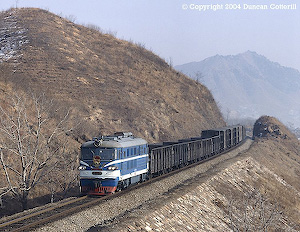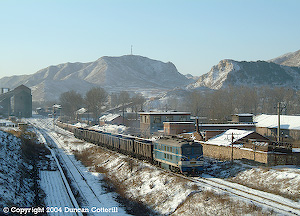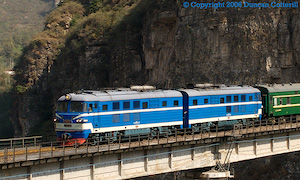BJ Class B'-B' Diesel-Hydraulics
The BJ is a compact and powerful single engined diesel-hydraulic B-B producing 2700 hp / 2000 kW with a maximum speed of 120 km/h. The design is unusual in pairing a medium speed diesel engine with hydraulic transmission. Over 300 were built by Beijing's February 7th works between 1975 and 1991.
BJ 3242 and BJ 3240 teamed up at Beijing's main station to work train 59, the overnight express to Changchun on 19 January 1991. The BJ would work to Shanhaiguan where Shenyang Bureau traction would take over. The loco on the left is a class DFH5 on station pilot duties.
BJ stands for Beijing and appropriately, most BJ spent their working lives in Beijing bureau. For over a decade they dominated express and local passenger traffic around the capital. The decline of the class began in the early 1990s when DF4 and DF4B started to oust BJs from longer distance passengers. The hydraulics were displaced onto secondary passenger and freight workings around Beijing bureau, helping to eliminate steam from a number of routes. By the end of the 1990s many DF4 had themselves been cascaded onto the secondary lines and large scale withdrawal of BJs took place over the next few years.
A few BJs found themselves in industrial service but they don't appear to have been a great success. Hardly surprising as they were primarily designed for express passenger work. In 2006 a handful could still be seen around Beijing on empty stock workings.
In addition to the standard BJs, numbered in the BJ 3xxx series there were a number of variations, none of which were built in large numbers.
Around 16 locos were built for service in the Manzhouli area close to the Russian border in north eastern Inner Mongolia. These engines were geared for freight service and a small number had 5' gauge bogies for working the transshipment yards. The standard guage locos were numbered in the BJ 10xx series while the Russian guage engines had BJ 11xx numbers. None are thought to remain in service although a line of stored BJs were noted at Hailaer depot in March 2006.
Another small batch was built with single cabs and numbered in the BJ 2xxx series. These locos were designed to work in pairs, coupled back to back. In the late 1980s and early 1990s heavy passenger trains from Beijing were often hauled by pairs of standard BJs and the BJ 2xxx locos may have been intended for these duties. Most are still in traffic in 2006 and they can be found working passenger trains on the scenic Beijing - Taiyuan line. One or two can often be seen stabled at the depot a short distance to the east of Beijing station. Unlike some Chinese twin unit locos, each "half-loco" is individually numbered and the pairings don't appear to be permanent.



